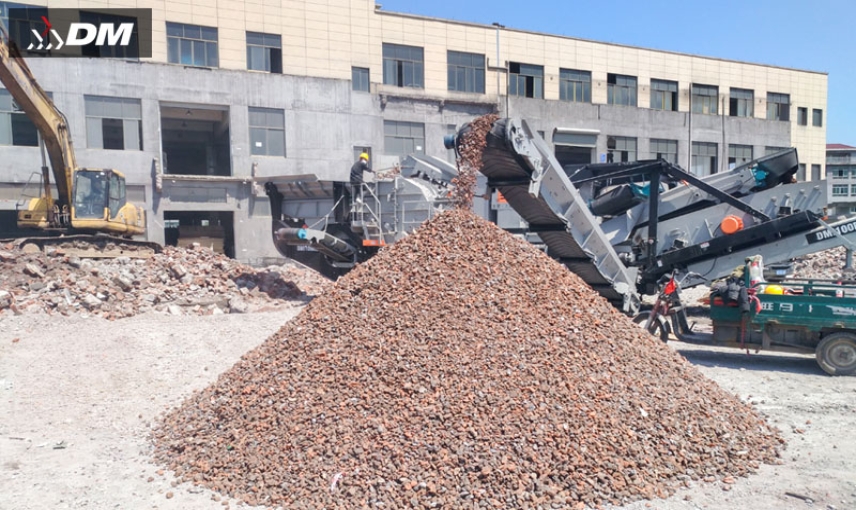
Screening Principles and Classification of Construction Waste
The core principle of construction waste screening is "classified screening, making the best use of materials, and safety & environmental protection". It is necessary to first separate waste by composition and recyclability, then achieve precise resource recovery through multi-stage screening. Classification focuses on three directions: "recyclable", "harmlessly treatable", and "needing special disposal" to minimize environmental pollution and resource waste.
<!-- Screening Principles Section -->I. Screening Principles: 4 Core Guidelines for Operation
1. From Coarse to Fine, Multi-Stage Screening
Priority is given to separating large-sized materials (such as waste concrete blocks and waste bricks) through coarse screens (e.g., vibrating screens with 50-100mm apertures). Then, medium screens (20-50mm apertures) and fine screens (5-20mm apertures) are used to separate small and medium particles. Finally, impurities (such as steel bars and plastics) are extracted through processes like magnetic separation and air separation. Avoid directly using fine screens to process mixed waste, which prevents screen hole blockage and improves screening efficiency.
2. Differentiated Treatment Based on Component Characteristics
Select screening methods according to the physical properties of construction waste components:
- Hard materials (waste concrete, bricks and stones): Classify by particle size using vibrating screens for recycled aggregates;
- Light impurities (plastics, wood, fabrics): Remove through air separation (using air flow to separate light and heavy substances) or manual sorting to avoid mixing into recycled aggregates and affecting quality;
- Metal impurities (steel bars, wire): Separate by adsorption with magnetic separators for centralized recycling and reuse.
3. Prioritize Recycling and Reuse, Reduce Landfilling
Resource recovery is the core goal during screening. Recyclable recycled aggregates (such as 5-20mm waste concrete particles) should be collected separately for producing recycled concrete, permeable bricks, etc. Inert waste with no direct utilization value (such as a small amount of silt and slag) should be centrally treated harmlessly. Random landfilling is strictly prohibited to reduce pollution to soil and groundwater.
4. Safety & Environmental Protection, Control Secondary Pollution
Screening operations must be equipped with dust and noise control equipment (such as spray systems and sound insulation covers) to prevent dust diffusion and mechanical noise from disturbing residents. Screened waste should be stacked by category with clear signs (e.g., "Recycled Aggregate Area", "Hazardous Waste Area") to prevent secondary pollution caused by mixing different types of waste. At the same time, ensure operators wear protective equipment (safety helmets, dust masks).
II. Classification Standards: 3 Categories by "Recyclability"
Construction waste classification should be combined with screening results to clarify the disposal path of different types of materials, which can be specifically divided into the following 3 categories:
1. Recyclable Category: Core Recovery Targets
These materials can be reused in production after screening and processing, and are the focus of construction waste resource utilization, mainly including:
- Recycled aggregate raw materials: Hard materials such as waste concrete blocks, waste bricks, and waste stone. After crushing and screening, they form recycled aggregates of different particle sizes (e.g., 0-5mm fine aggregates, 5-20mm medium aggregates) for making recycled bricks, recycled concrete, roadbed fillers, etc.;
- Metal materials: Waste steel bars, wire, aluminum alloy doors and windows, etc. After separation by magnetic separation or manual sorting, they are sent to steel mills for smelting and recycling to produce steel again;
- Other recyclables: Waste wood (such as waste formwork and wooden squares) can be used to make simple supports or as fuel after disinfection and cutting; waste plastics (such as plastic pipes and packaging films) are centrally recycled for granulation and reuse in producing plastic products.
2. Harmlessly Treatable Category: Requiring Stabilization Treatment
These materials have no direct utilization value but will not cause environmental harm after harmless treatment, mainly including:
- Inert waste: A small amount of residual silt, slag, and uncrushable large impurities (such as ceramic fragments) after screening. They are landfilled after compaction and covering, or used for site leveling and foundation backfilling to avoid occupying high-quality landfill space;
- Light impurities: A small amount of unrecyclable waste fabrics, waste paper scraps, etc. After compression, they are sent to waste incineration plants for incineration power generation or sanitary landfilling to reduce volume occupation.
3. Special Disposal Category: Strict Control to Prevent Pollution
These materials contain harmful substances and need to be collected and disposed of separately in accordance with hazardous waste management standards to avoid environmental pollution, mainly including:
- Hazardous construction waste: Waste paint buckets (with residual paint), waste waterproof materials (such as asphalt felt), waste thermal insulation materials (such as formaldehyde-containing insulation boards). These materials should be collected in sealed containers and handed over to qualified hazardous waste treatment enterprises for incineration or chemical treatment to prevent leakage of harmful substances;
- Radioactive substances: In rare cases, mixed radioactive waste (such as radioactive components in waste medical equipment) should be isolated immediately and disposed of by professional institutions in accordance with radioactive waste management regulations. Mixing with other waste is strictly prohibited.
Prev Post
No More...




We will answer your email shortly!